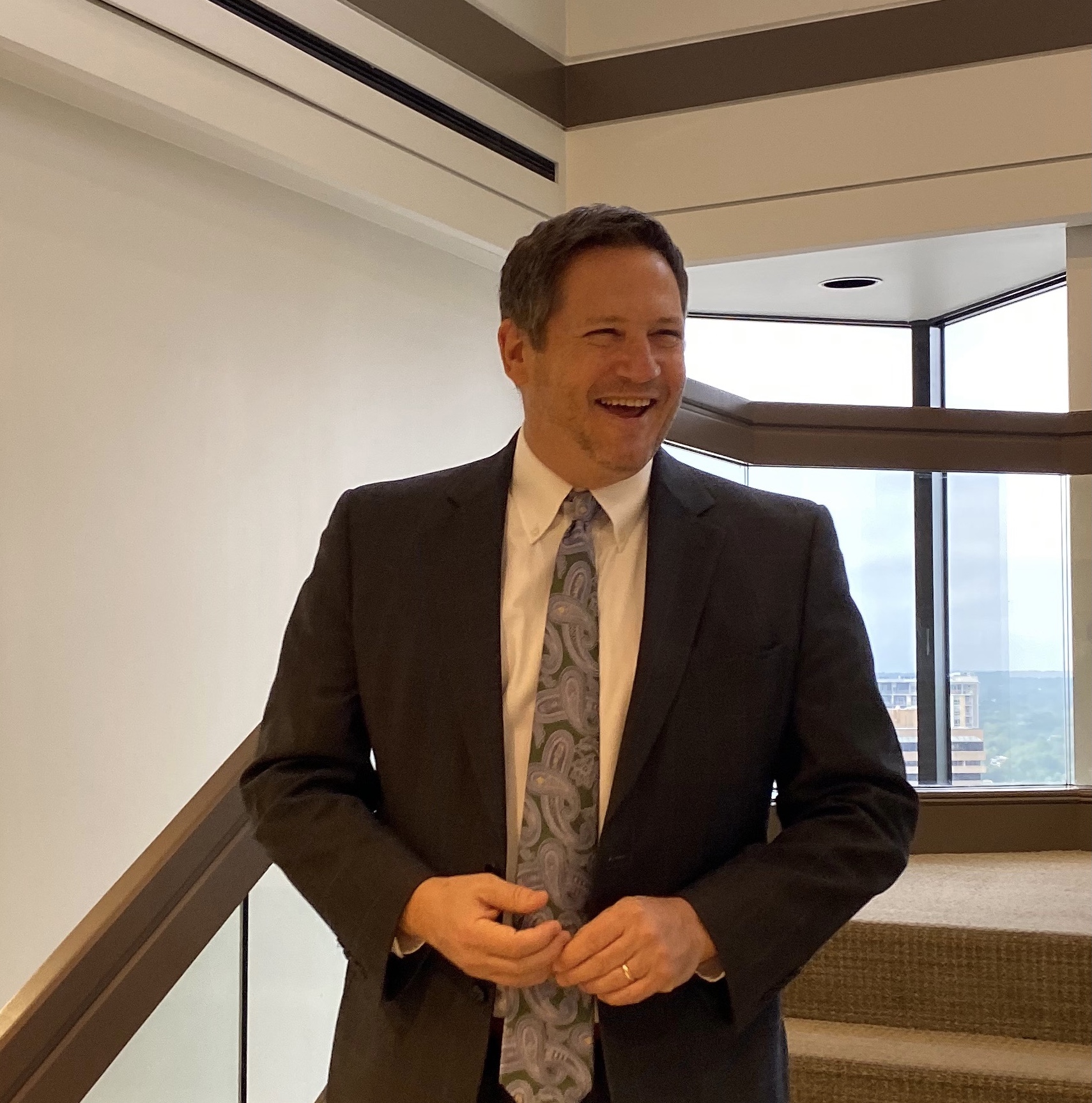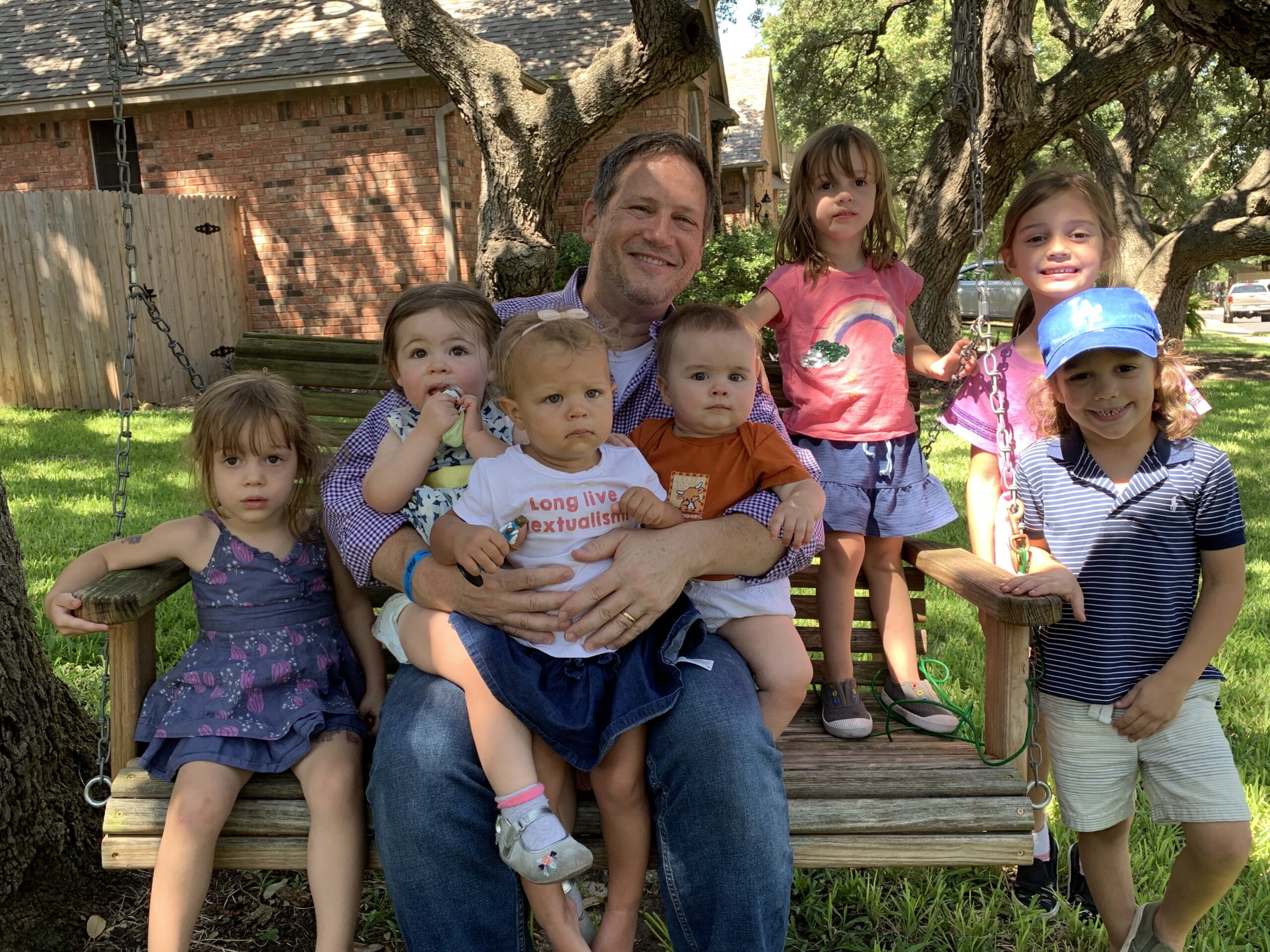The wooden name plate reads “(Boyd, J. dissenting).”
Displayed on newly retired Texas Supreme Court Justice Jeff Boyd’s desk in his home office, the parting gift from a pair of law clerks serves as a reminder of Boyd’s role on a remarkably cohesive court.
Boyd, who served from December 2012 until Labor Day 2025, authored 72 majority opinions and 62 dissents during his tenure.
“I was by far the most dissenting justice overall during my period on the court,” said Boyd, his face relaxing into its trademark grin as he shows off the name plate during a video interview.
The 63-year-old jurist reflected on his service on the court and prior jobs with the governor’s and attorney general’s offices in a recent interview with The Texas Lawbook. He also spent 15 years with Thompson & Knight in two stints between his executive branch roles.
The affable jurist has no solid plans for future employment, but he is entertaining offers from law firms and arbitrators, considering offers to join boards of Texas-based companies and pondering how to use his voice to address his growing concerns about separation of powers.
A policy-oriented approach to the law by budding law students has bled into the judiciary, Boyd worries. He points to conservative backlash to U.S. Supreme Court Justice Amy Coney Barrett as evidence that a good portion of the public believes judges ought to be fighting the cause, whatever the cause may be.

“I think more and more all you have to do is read media reports and comments on social media to see that the public tends to think, well, if this judge isn’t voting in favor of this cause in this case, then they’re not the conservative I thought they were,” he said.
“If the public loses faith in the judiciary’s ability to honestly, predictably and consistently apply the law as written, that’s the real threat to our form of government.”
Boyd is still not completely sure why he decided to retire from the court.
“Part of it was, you know, when you do something for a long time, you just don’t have the zeal for it that you once did. And if you lack that zeal, you may lack that quality that you brought to it when you were much more zealous about it, and I didn’t want to wither on the vine,” Boyd said. “So that was part of it, just feeling like it’s probably time to let someone with a little more zeal and passion about it to come on in.”
He also didn’t want to run for reelection next year, saying he wasn’t sure he wanted to put in the necessary energy to raise money and campaign. The judiciary is becoming more politically polarized for voters, he believes.

“I wasn’t interested in the politics of the way it is today,” Boyd said. “And I do wish, I hope maybe in the future to have some impact on the efforts that are out there to help better educate the public about what we need our judges to be in terms of politics and policy and independence from the other branches and calling balls and strikes and not being results-oriented.”
More time to spend with his family, which includes his wife Jackie, twin daughters, a son, a 1-year-old grandson and an elderly father, was also a motivator.
Asked why he followed the pattern of justices who leave midterm, allowing the governor to name their replacement, Boyd said he wanted to honor the “golf etiquette of political appointments.” Just as he was named by then-Gov. Rick Perry to replace Dale Wainwright nearly two years before the 2014 general election, Gov. Greg Abbott will be able to name a justice a little over one year before the 2026 general election.
“It gives the governor — if he chooses to appoint right away — it gives him the opportunity to put someone in immediately and they can be there for the very first set of oral arguments. It gives them three months to raise the basic funds and get the signatures and do the things they need to do before the filing deadline at the beginning of December,” said Boyd.
Pepperdine Pipeline
Boyd grew up in an Air Force family, moving around the country and overseas. He is a graduate of Round Rock High School and Abilene Christian University, where he majored in Biblical studies. He served for five years as a youth and family minister at Austin’s Brentwood Oaks Church of Christ.
He earned his law degree summa cum laude from Pepperdine University where he graduated second in his law school class. Out of his first-year class of 337 students, he knew of only one who was seeking a law degree so she could fight for a cause, in her case pro-life advocacy.
“Nowadays, if you go to law school and you’re not there for some cause, you shouldn’t be there, you know? You’ve got to be in this club or Federalist Society,” he said. “It’s like all the applications I get from these potential law clerks are all touting that they’re there to fight for this reason or that reason, instead of just the purity of learning the law and then helping people with what you’ve learned.”
For the last seven or eight years, Boyd has filled one of his law clerk positions with a Pepperdine student, looking for those who wanted to practice in Texas.
Not coming from a family of lawyers, Boyd said he didn’t know much about the importance of a clerkship. His law school dean suggested he interview for a position with the federal Ninth Circuit Court of Appeals.
He interviewed with Judge Pamela Ann Rymer, who was on the short list for the U.S. Supreme Court. Then he met Fifth Circuit Judge Thomas M. Reavley, a member of Pepperdine’s board of visitors who also was looking for a law clerk.
The two had a lengthy conversation and hit it off. Reavley said he would hold a spot open for Boyd but advised him to accept an offer from Rymer if one came because she was an up-and-comer.
“And I went back to Pepperdine, and the next day I called and withdrew my application from Rymer and said, ‘That’s the kind of guy I want to work for right there,’” Boyd recalled. He has said that Reavely taught him how important it is that judges fairly apply the law regardless of their personal or political preferences.

Private Practice to Government Service, Times Two
After completing his clerkship, Boyd in 1992 joined the Austin office of Thompson & Knight, trying his first jury case after three months, a benefit of being in a branch office of a major firm. He spent the next eight years litigating cases and arguing appeals.
Boyd had just made partner when John Cornyn, who was elected Texas attorney general in 1998, called in 2000 looking for a new deputy AG. Boyd had gotten to known Cornyn in the early 1990s after Cornyn was elected to the Texas Supreme Court.
Both men had grown up in the Church of Christ, and fellow lawyers kept asking Boyd if he knew Cornyn. Boyd was in the buffet line at a meeting of the Calvert Inns of Court when Cornyn came up and introduced himself.
When Cornyn resigned from the court to run for AG, he worked as counsel at Thompson & Knight in an office around the corner from Boyd. The two worked together on a few of Boyd’s cases.
Boyd spent three years running litigation for Cornyn, steering major cases on school finance, Enron’s bankruptcy, a crisis in the homeowners’ insurance market and denial of Medicaid funding for abortions.
On his home office wall hangs a courtroom artist sketch of the first hearing in the Enron bankruptcy case, where Texas filed a motion to transfer venue from Manhattan to Houston.
“Honestly, we knew we were going to lose, but we felt like we had to go down fighting on that issue,” said Boyd. “And of course a bunch of the creditors wanted it in Houston as well. And so, they joined our motion, and we ended up going for this big hearing. And the strategy became that I would get up as the representative of the attorney general and make the passionate plea on behalf of the people of Texas and then let the real lawyers get up and make the technical report.”
Cornyn was elected to the U.S. Senate in 2002, and Boyd stayed on under the new AG, Greg Abbott, until August 2003 when he returned to Thompson & Knight as a senior partner.
In January 2011, Boyd left the firm to become general counsel and later chief of staff to Perry. One of his duties was interviewing judicial candidates, and he took the call when Wainwright decided to leave the court.
Boyd said when he called Abbott’s chief of staff to say he was going to retire he suggested a candidate — whom he won’t name — for the position.
“And they were polite and happy to receive my input, but they didn’t give me any feedback on what they’re thinking. And nor did I when I was there,” he said.

The Great Dissenter
While Boyd certainly wrote his share of important majority opinions, it was his willingness to dissent that made him stand apart from his colleagues. During several terms he agreed with his fellow justices in fewer than 75 percent of divided cases, according to voting analyses by SCOTX Blog.
One of Boyd’s early dissents illustrates his philosophy of construing a statute the way it is written. In the 2013 case of Morton v. Nguyen, Boyd disagreed with the majority’s decision in a case interpreting a contract for deed. He said the Legislature had modified the law to address abuses by property owners when renters missed a payment under an agreement set up to allow them to eventually own the home.
The majority found the seller was entitled to an offset of the rental value of the property. Two justices joined Boyd’s dissent that the court should have applied the statute as written, entitling the buyer to “a full refund of all payments made to the seller.”
“The court ruled that the plaintiff in this case could not get a refund of all the rent that they paid through the years because there was value to having lived there through all those years. A very commonsensical outcome. It’s just that’s not what the statute says,” Boyd told The Lawbook.
In a 2015 case, Boyd dissented to the court’s holding that there was insufficient evidence to support a jury’s finding of a design defect in a fatal Genie lift accident. In his opinion, Boyd said if he had been a juror he probably would have sided with Genie due to misuse of the lift that cause it to destabilize.
“But I cannot say that my view is the only reasonable one. After five days of trial, ten members of this jury found that Genie’s lift was defectively designed. Because there is some evidence in the record to support that verdict, the Court must affirm, even if each of us would have reached a different verdict. Thanking all twelve jurors for their service in this case, I respectfully dissent.”
Boyd said he also sometimes dissented in mandamus cases over the abuse of discretion standard.
“I just feel like abuse of discretion means abuse of discretion, that the mere fact that I disagree with what they ruled doesn’t allow me to reverse them,” he said.
When Boyd’s seniority afforded him one of the nicer judicial chambers with a balcony overlooking the Capitol, he began inviting the other justices to “a little kumbaya reception.”
“Just the nine of us and we will just enjoy each other’s company to wind down after a difficult conference,” he said. “We gather together on the balcony and have time to just sit down as colleagues and not talk about cases and disagreements, and instead just remember the value that each person brings and enjoy being together.”
Justice Jane Bland is moving into Boyd’s office, and he knows she will be a great host.
Representative Cases
Justice Boyd authored 72 majority, three plurality, 62 dissenting and 29 concurring opinions.
Majority
Crosstex North Texas Pipeline v. Gardiner, 2016. Ranch owners alleged that a compressor station built by Crosstex created a nuisance. SCOTX upheld the court of appeals’ reversal of a $2 million jury verdict and remand for a new trial. The opinion clarified that “nuisance” describes a particular legal injury that could lead to a cause of action. A unanimous court led by Boyd held that defendants can be liable for nuisance if their conduct is intentional or negligent and substantially interferes with the use and enjoyment of the land.
Malouf v. State of Texas ex rel. Ellis, 2024. A divided 6-2 SCOTX determined that a $16.5 million civil penalty the state leveled against a dentist after a summary judgment win in a Medicaid fraud lawsuit could not stand due to the plain language of the statute. Boyd’s decision hinged on the Legislature’s use of the word “and” instead of “or.”
Horton v. The Kansas City Southern Railway Co., 2024. The case arose from a fatal collision between a vehicle driven by the plaintiffs’ mother and a train. Two theories were submitted to the jury using a single broad-form negligence question. In a rare rehearing, a divided 7-2 court reversed the court of appeals and reinstated the trial court’s award to Horton. The opinion authored by Boyd concluded that federal law does not preempt the negligence claim on the humped railroad crossing; there was insufficient evidence to support the claim that a missing yield sign proximately caused the accident; and the use of a broad-form question encompassing both allegations did not constitute harmful error.
Dissents
Morton v. Nguyen, 2013. In a dispute over a homebuyer’s recission of a contract for deed after three years of making payments, the Supreme Court found that the seller was entitled to an offset of the rental value of the property. Two justices joined Boyd’s dissent that the court should have applied the statute as written, which allowed the buyers, unconditionally, “to a full refund of all payments made to the seller.”
Genie Industries v. Matak, 2015. The court held that there was insufficient evidence to support a jury’s finding of a design defect in a fatal accident in which the lift was intentionally misused. Two justices joined Boyd’s dissent disagreeing with the majority’s decision to replace the jury’s judgment with its own as a matter of law.
Webster v. Commission for Lawyer Discipline, 2024. The case arose from grievances filed against the first assistant attorney general alleging a lawsuit filed challenging the results of the 2020 presidential election contained false statements. The Supreme Court agreed with the trial court that the commission’s petition was barred by the separation-of-powers doctrine. Boyd, joined by another justice, said that the disciplinary proceeding could fail for many reasons but “separation of powers is not one of them.”
